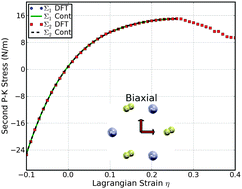Outstanding mechanical properties of monolayer MoS2 and its application in elastic energy storage
Abstract
The structural and mechanical properties of graphene-like honeycomb monolayer structures of MoS2 (g-MoS2) under various large strains are investigated using density functional theory (DFT). g-MoS2 is mechanically stable and can sustain extra large strains: the ultimate strains are 0.24, 0.37, and 0.26 for armchair, zigzag, and biaxial deformation, respectively. The in-plane stiffness is as high as 120 N m−1 (184 GPa equivalently). The third, fourth, and fifth order elastic constants are indispensable for accurate modeling of the mechanical properties under strains larger than 0.04, 0.07, and 0.13 respectively. The second order elastic constants, including in-plane stiffness, are predicted to monotonically increase with pressure while the Poisson ratio monotonically decreases with increasing pressure. With the prominent mechanical properties including large ultimate strains and in-plane stiffness, g-MoS2 is a promising candidate of elastic energy storage for clean energy. It possesses a theoretical energy storage capacity as high as 8.8 MJ L−1 and 1.7 MJ kg−1, or 476 W h kg−1, larger than a Li-ion battery and is environmentally friendly.


 Please wait while we load your content...
Please wait while we load your content...